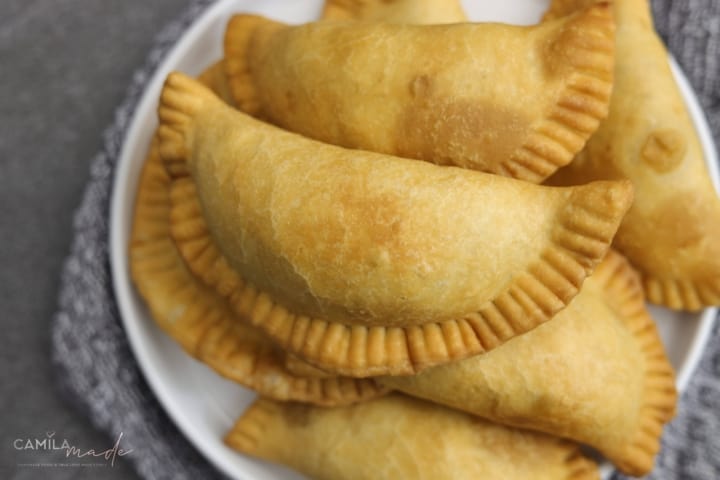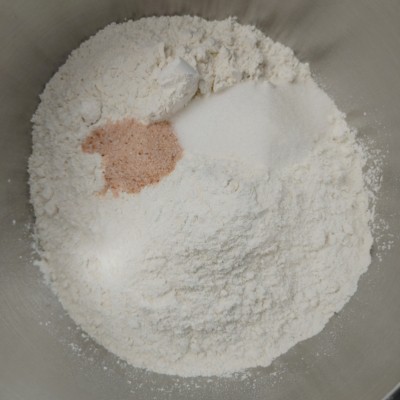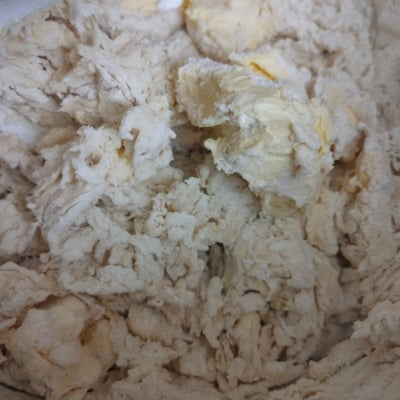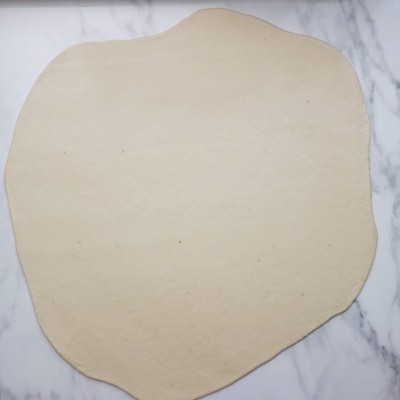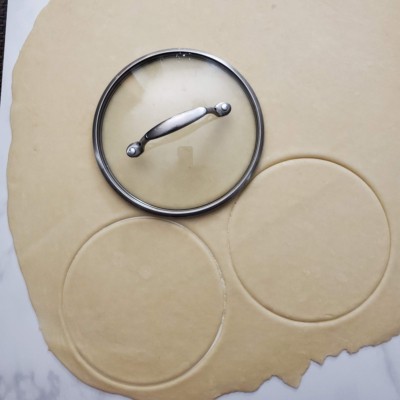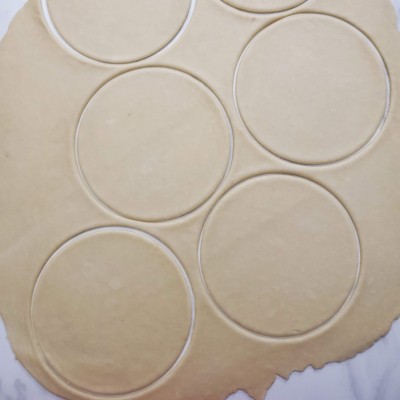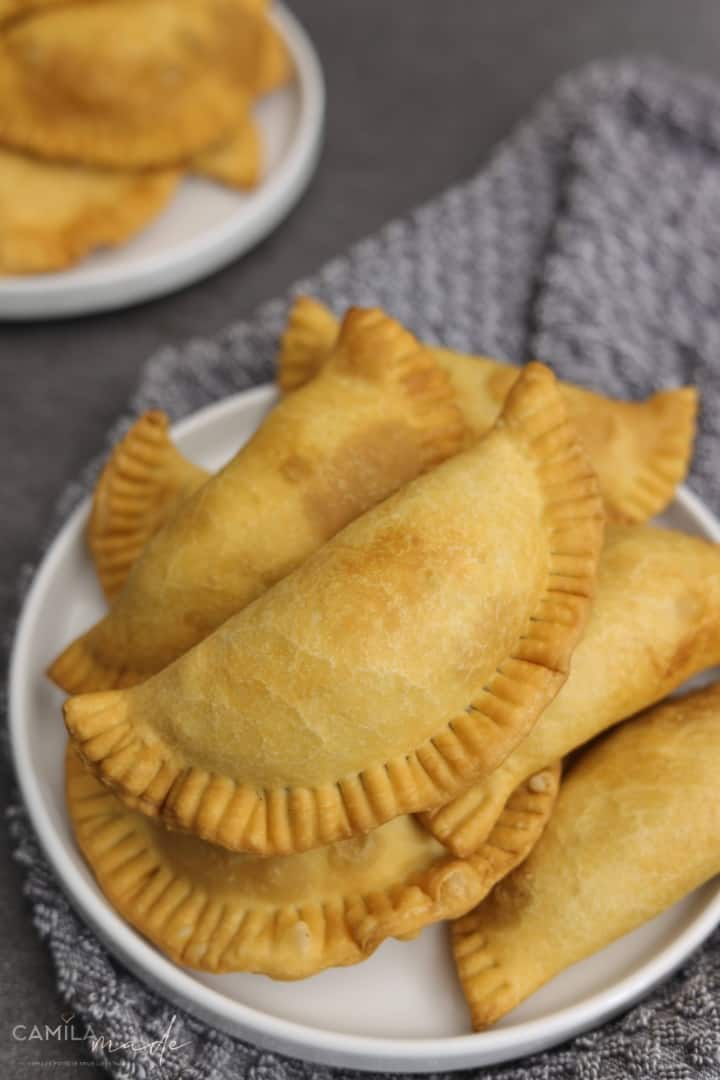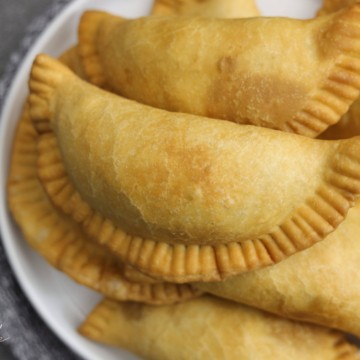We eat a lot of empanadas at home, and this Paraguayan-inspired fried empanada is one of our favorite dishes! This Empanada (besides being delicious) is simple to make and requires only a few pantry ingredients.
The filling consists of shredded beef, spices, and vegetables; chopped hard-boiled eggs are also in the meat mixture.
These empanadas are also juicier than most other varieties because they include a good amount of onion in the mix; the onion keeps the meat filling moist. The filling is enclosed in dough consisting of all-purpose flour, butter, water, and salt.
Finally, these empanadas are deep-fried in hot oil until golden brown. Pair with this Mango Habanero Sauce for a sweet, savory, and spicy contrast.
Jump to:
How to Make Empanada Dough
In the bowl of a stand mixer fitted with the dough hook attachment, combine flour, softened butter, sugar, and salt on medium speed until thoroughly blended.
With the motor running, slowly add cold water and mix until a soft and pliable dough forms, 7 to 10 minutes. Transfer to a clean work surface lightly dusted with flour and kneaded one or two times, just enough to form a neat ball.
Transfer to a large bowl, wrap in plastic wrap, and refrigerate for at least 30 minutes or up to overnight.
On an unfloured flat work surface, roll the dough into a ⅛-inch thick sheet; let the dough rest for 10 minutes. Then, cut out the disc using a 5—to 6-inch round cutter or saucer; depending on how large you prefer, I use a 6'' glass lid.
Then, gather the scraps, add to the rest of the dough, and roll out another batch of circles; repeat with the rest of the scraps.
Cover the discs with cling film and chill while you prepare the filling. If not used immediately, use wax or parchment paper to separate the stack and refrigerate or freeze it for later use.
How to Make Hard-Boiled Eggs
Place the eggs in a pot of water on the stovetop, with at least an inch of water covering them. Simmer the eggs. Turn on the heat and bring the water to a rolling boil. Simmer the eggs in boiling water for fifteen minutes to get firm whites and yolks.
Using a slotted spoon, remove the eggs from the pot and place them in an ice bath in a large bowl. Cooling the eggs in cold water will halt the cooking process and make handling the eggs easier when peeling.
When the eggs are completely cool to room temperature—about fifteen minutes—gently tap the egg on the counter or table to crack the peel. Tap the top end of the egg and the bottom end before tapping the egg's sides to break up the eggshell.
Carefully peel the egg, starting from the wide bottom end of the egg, to break the air pocket between the egg and the shell. Then, gently peel off the shell to avoid breaking the egg whites.
Pat, dry them with a paper towel and place them into a bowl. Using a fork, mince the eggs, cover them with plastic wrap, and store them in the refrigerator until ready to use.
How to Make Beef Filling
In a large nonstick pot, combine beef, 2 tablespoons olive oil, water, beef bouillon, black pepper, red pepper flakes, cumin, paprika, and garlic; stir and bring to a simmer over medium-high heat.
Reduce heat to low, cover, and simmer, occasionally stirring, until beef is tender for about 1 hour. Remove lid and increase heat to high until it dries up to a juicy but dry look for about 3 to 5 minutes.
Add the onions and peppers and cook until soft, about 10 minutes. Add parsley and cook for another 10 minutes to eliminate any excess liquid; the mixture should be moist but not runny.
Taste and adjust seasoning if needed. Then, working in batches, transfer the meat mixture to a food processor or blender and pulse until it is coarsely shredded; don't overdo it, or you'll need up with puree.
Next, transfer each batch of shredded meat mixture into a large mixing bowl and mix in the minced eggs. Let it cool to room temperature, then cover and refrigerate until ready to use.
How to Assemble
Line 2 large baking sheets with parchment; set aside.
Once the beef has cooled, working quickly so the dough doesn’t warm too much in your hands, portion about 2 spoonfuls in the middle of each empanada disc, leaving a 1-inch border around the edge.
Avoid reaching the edges with the filling because oiliness will prevent a good seal.
Moisten the tip of your finger with a small amount of water and moisten the edges of the circle with your finger around half the border; then gently fold over until the edges meet to seal into a half-moon shape.
Crimp the edges with a fork, removing air pockets as you go. Repeat with the remaining rounds and filling. Place them in the refrigerator to chill until you are ready to fry them.
How to Fry
In a 2-quart pot, heat the peanut oil to 350 degrees F. Gently slip 2 to 3 empanadas into the hot oil and fry until golden brown, 3 minutes per side, adjusting the heat as needed.
Transfer to the paper towels to drain. Serve Hot.
Related Recipes:
Recipe
Easy Empanadas
Tools
Ingredients
For the Empanada Filling
- 1 kg (2.2 lbs) boneless Beef Chuck, trimmed and cubed
- 3 medium yellow onion , finely diced
- 1 Poblano Pepper or green bell peppers , finely chopped
- 1 red bell pepper , finely chopped
- 1 yellow or orange bell pepper , finely chopped
- 5 Garlic cloves , finely minced
- 2 Tablespoons extra virgin olive oil
- ¼ teaspoon ground black pepper; adjust to taste
- 1 teaspoon red pepper flakes; adjust to taste
- 1 tablespoon sweet paprika
- 1 tablespoon plus 2 teaspoons knorr beef flavor bouillon
- 1 tablespoon ground cumin , to taste (optional)
- 1 bunch fresh Italian parsley or cilantro , finely chopped ( stem removed)
- 4 hard-boiled eggs , chopped
- Himalayan Pink Salt or kosher salt, Taste and adjust seasoning with salt if necessary.
- 1.5 liter (6 cups) Peanut oil or sunflower for frying or any neutral frying oil
For the Empanada dough:
- 1kg kg (8 Cups) All purpose flour
- 300 g ( 2 sticks plus 5 tablespoons) unsalted butter, room temperature
- 2 teaspoons Pink Himalayan Salt or kosher salt
- 30 g (2 tablespoons) sugar
- 325 ml water, cold
Instructions
How to Make Empanada Dough
- In the bowl of a stand mixer fitted with the dough hook attachment, combine flour, softened butter, sugar, and salt on medium speed until thoroughly blended. With the motor running, slowly add in cold water and mix until a soft and pliable dough forms, 7 to 10 minutes.
- Transfer to a clean work surface lightly dusted with flour and kneaded one or two times, just enough to form a neat ball. Wrap in plastic wrap and set in the refrigerator for 4 hours up to overnight.
- On an un-floured flat work surface, roll out the dough into a ⅛ inch thick sheet; let the dough rest for 10 minutes. Then, cut out the disc using a 5 to 6 inches rounds cutter or saucer; depending on how large you prefer, I use a 6'' glass lid.
- Then, gather the scraps, add to the rest of the dough, and roll out another batch of circles; repeat with the rest of the scraps. Cover the discs with cling film and chill while you prepare the filling or if not used immediately, use wax or parchment paper to separate the stack and refrigerate or freeze to use later.
How to Make Hard Boiled Eggs
- Place eggs in a pot of water on the stovetop with at least an inch of water covering the eggs. Simmer the eggs. Turn on the heat and bring the water to a rolling boil. Simmer the eggs in boiling water for fifteen minutes to get firm whites and egg yolks.
- Using a slotted spoon, remove the eggs from the pot and place them in an ice bath in a large bowl. Cooling the eggs in cold water will halt the cooking process and make handling the eggs easier when peeling.
- When the eggs are completely cool to room temperature—about fifteen minutes—gently tap the egg on the counter or table to crack the peel. Tap the top end of the egg and the bottom end before tapping the egg's sides to break up the eggshell.
- Carefully peel the egg, starting from the wide bottom end of the egg to break the air pocket between the egg and the shell. Then, gently peel off the shell to avoid breaking the egg whites. Pat, dry with a paper towel, and places them into a bowl. Using a fork, mince the eggs, cover with plastic wrap, and store in the refrigerator until ready to use.
How to Make Empanada Filling
- In a large nonstick pot, combine beef, 2 tablespoons olive oil, water, beef bouillon, black pepper, red pepper flakes, cumin, paprika, and garlic; stir and bring to a simmer over medium-high heat.
- Reduce heat to low, cover, and simmer, occasionally stirring, until beef is tender for about 1 hour. Remove lid, and increase heat to high until and let dry up to a juicy but dry look for about 3 to 5 minutes.
- Add the onions and peppers and cook until soft, about 10 minutes. Add the parsley and cook for another 10 minutes to eliminate any excess liquid; the mixture should be moist but not runny.
- Taste and adjust seasoning if needed. Then, working in batches, transfer the meat mixture to a food processor or blender and pulse until it is coarsely shredded; don't overdo it, or you'll need up with puree. Next, transfer each batch of shredded meat mixture into a large mixing bowl and mix in the minced eggs. Let it cool to room temperature, then cover and refrigerate until ready to use.
How to Assemble
- Line 2 large baking sheets with parchment; set aside. Once the beef has cooled, working quickly, so the dough doesn’t warm too much in your hands, portion about 2 spoonfuls in the middle of each empanada disc, leaving a 1-inch border around the edge; avoid reaching the edges with the filling because oiliness will prevent a good seal.
- Moisten the tip of your finger with a small amount of water and moisten the edges of the circle with your finger around half the border; then gently fold over until the edges meet to seal into a half-moon shape.
- Crimp the edges with a fork, removing any air pockets as you go. Repeat with the remaining rounds and filling. Place the empanadas in the refrigerator to chill until you are ready to fry them.
How to Fry Empanadas
- In a 2-quart pot, heat the peanut oil to 350 degrees F. Gently slip 2 to 3 empanadas at a time into the hot oil and fry until golden brown, 3 minutes per side, adjusting the heat as needed. Transfer to the paper towels to drain. Serve Hot.
Notes
All nutritional information is based on third-party calculations and is only an estimate. Each recipe and nutritional value will vary depending on the brands you use, measuring methods, and portion sizes per household.

